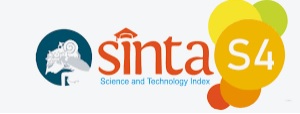Rancangan Arsitektur Enterprise Pada Industri Restoran
Abstract
Abstrak. Industri restoran merupakan industri yang mempunyai potensi menjanjikan dan mengalami perkembangan yang sangat cepat. Dengan berkembangnya teknologi digital, industri restoran juga harus melakukan inovasi dalam pemanfaatan teknologi tersebut. System yang digunakan dalam melakukan pelayanan ke pelanggan, masih kurang maksimal. System informasi hanya menggunakan front end di kasir, serta back end menggunakan system pencatatan barang keluar masuk (system inventory), system keuangan. Management restoran melakukan perubahan system informasi menjadi lebih baik, dengan cara melakukan IT Planning sebelum melakukan perubahan sistem informasi. Penggunaan Enterprise Architecture sebagai landasan dalam melakukan perencanaan, menggunakan Framework TOGAF. Framework TOGAF yang digunakan dalam perancangan adalah Preliminary Phase, Business Architecture, Application Architecture, Information Architecture, Technology Architecture dan Implementation Governance. Implementation Governance dilakukan untuk tahap penerapan dari Enterprise Architecture pada industri restoran.
Kata kunci: Enterprise Architecture, Implementation Governance, TOGAF, Business Architecture, Application Architecture
Abstract. The restaurant industry is an industry that has promising potential and is experiencing very fast development. With the development of digital technology, the restaurant industry must also innovate in the use of this technology. The system used in providing services to customers is still not optimal. The information system only uses the front end at the cashier, and the back end uses the inventory system and the financial system. Restaurant management changes the information system for the better, by doing IT Planning before making changes to the information system. The use of Enterprise Architecture as a basis for planning, using the TOGAF Framework. The TOGAF framework used in the design is Preliminary Phase, Business Architecture, Application Architecture, Information Architecture, Technology Architecture and Implementation Governance. Implementation Governance is carried out for the implementation stage of the Enterprise Architecture in the restaurant industry.
Keyword: Enterprise Architecture, Implementation Governance, TOGAF, Business Architecture, Application Architecture
References
Dumitriu, D., & Popescu, M. A. M. Enterprise architecture framework design in IT management. Procedia Manufacturing, 2020, 46: 932-940. doi:10.1016/j. promfg.2020.05.011.
Dantu, B., & Smith, E. Medical process modeling with a hybrid system dynamics Zachman framework. Procedia Computer Science, 2011, 6: 76-81. doi: 10.1016/j.procs. 2011.08.016.
Lnenicka, M., & Komarkova, J. Developing a government enterprise architecture framework to support the requirements of big and open linked data with the use of cloud computing. International Journal of Information Management, 2019, 46: 124-141. doi: 10.1016/j.ijinfomgt.2018.12.003.
Nur’aeni, W., Sembiring, F., & Erfina, A. Implementasi TOGAF Pada Perancangan Sistem Informasi Reservasi Berbasis Progressive Web Application. Jutisi: Jurnal Ilmiah Teknik Informatika dan Sistem Informasi, 2021, 10(2): 161-172.
Gumilar, M. D., Sembiring, F., & Erfina, A. Implementasi Progressive Web App pada Sistem Informasi E-learning untuk Pembelajaran Bahasa Pemrograman Python. Jutisi: Jurnal Ilmiah Teknik Informatika dan Sistem Informasi, 2021, 10(2): 187-196.
J.- Leonidas J., Andry J.F., Perancangan Enterprise Architecture Pada Pt.Gadingputra Samudra Menggunakan Framework Togaf Adm, J. Teknoinfo, 2020, 14(2): 71, doi: 10.33365/jti.v14i2.642.
Yamamoto, S., Zhi, Q., & Zhou, Z. Aspect Analysis towards ArchiMate Diagrams. Procedia Computer Science, 2019, 159: 973-980. doi: 10.1016/j.procs. 2019.09.264
Montenegro, J. F., Contreras, P. A., & Sáenz, F. Hybridization of the Kano model and business model canvas: aeronautical and metalworking industry in Bogota, Colombia. Heliyon, 2021, 7(10): e08097. doi: 10.1016/j.heliyon.2021.e08097.
Rubrichi, S., Battistotti, A., & Quaglini, S. Patients’ involvement in e-health services quality assessment: a system for the automatic interpretation of SMS-based patients’ feedback. Journal of biomedical informatics, 2014, 51: 41-48. doi: 10.1016/j.jbi. 2014.03.003
Ryu, S., & Park, Y. N. How consumers cope with location-based advertising (LBA) and personal information disclosure: The mediating role of persuasion knowledge, perceived benefits and harms, and attitudes toward LBA. Computers in Human Behavior, 2020, 112: 106450. doi: 10.1016/j.chb.2020.106450
Sureshkumar, V., Anitha, R., Rajamanickam, N., & Amin, R. A lightweight two-gateway based payment protocol ensuring accountability and unlinkable anonymity with dynamic identity. Computers & Electrical Engineering, 2017, 57: 223-240. doi: 10.1016/j. compeleceng.2016.07.014.
Chen, G. Q., Wu, X. D., Guo, J., Meng, J., & Li, C. Global overview for energy use of the world economy: Household-consumption-based accounting based on the world inputoutput database (WIOD). Energy Economics, 2019, 81: 835-847. doi: 10.1016/j. eneco.2019.05.019.
Anggraini, N., & Legowo, N. Cloud Computing Adoption Strategic Planning Using ROCCA and TOGAF 9.2: A Study in Government Agency. Procedia Computer Science, 2019, 161: 1316-1324. doi: 10.1016/j.procs.2019.11.247
Badii, C., Bellini, P., Cenni, D., Difino, A., Nesi, P., & Paolucci, M. Analysis and assessment of a knowledge based smart city architecture providing service APIs. Future Generation Computer Systems, 2017, 75: 14-29. doi: 10.1016/j.future.2017.05.001.
Braun, A. T., Schöllhammer, O., & Rosenkranz, B. Adaptation of the business model canvas template to develop business models for the circular economy. Procedia CIRP, 2021, 99: 698-702. doi: 10.1016/j.procir.2021.03.093
How To Cite This :
Refbacks
- There are currently no refbacks.











